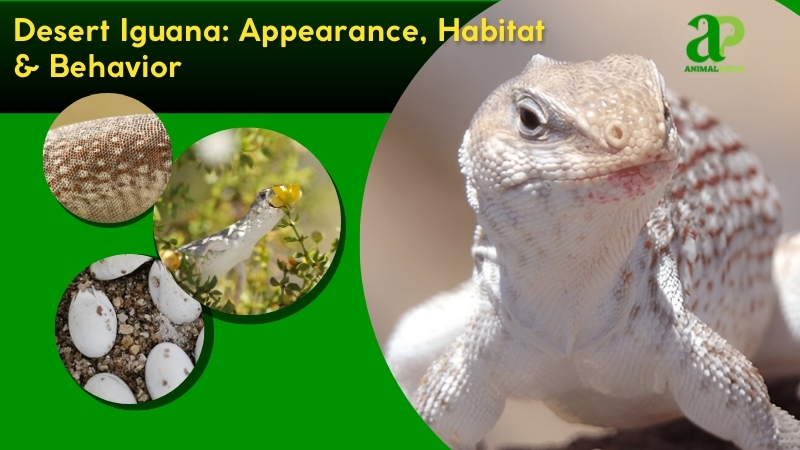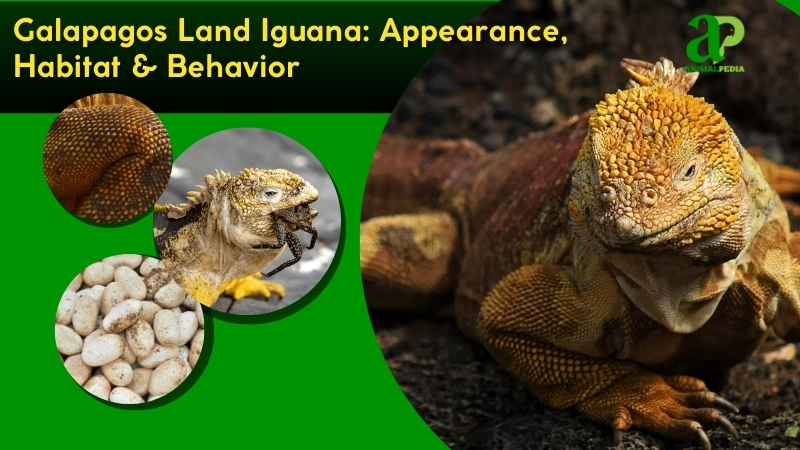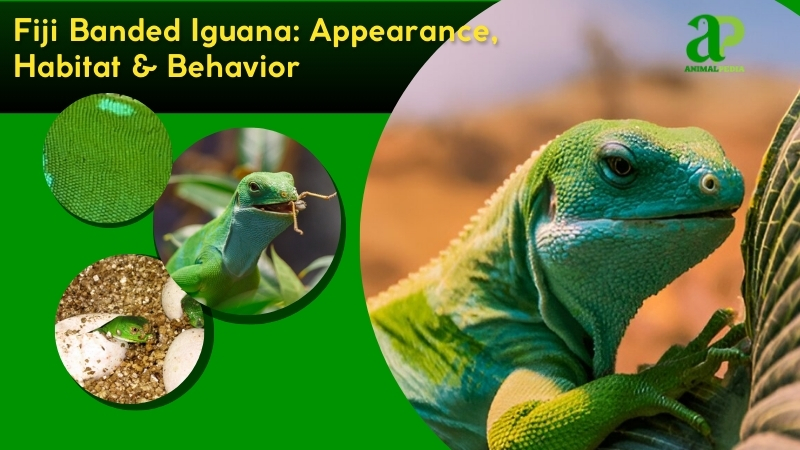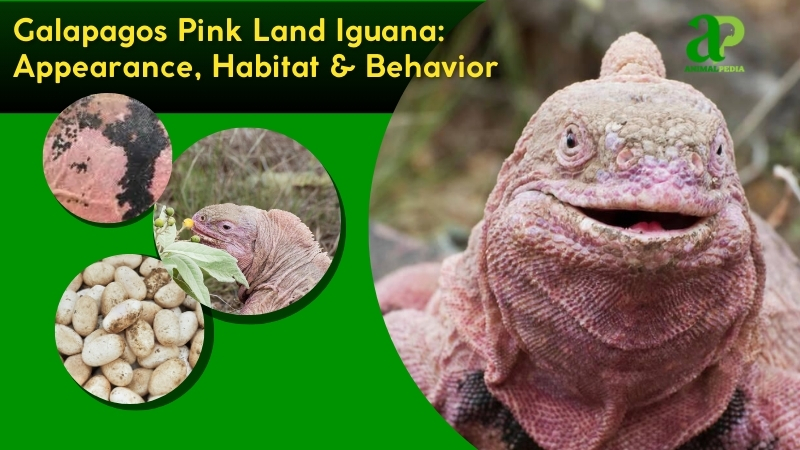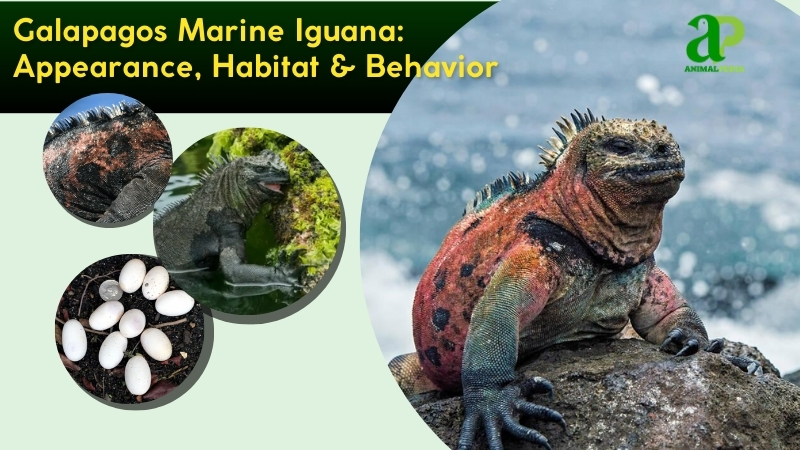The Cuban Rock Iguana, also known as Cyclura nubila or Cuban Ground Iguana, is a reptile species native to specific islands in the Caribbean, including Cuba, the Bahamas, and the Cayman Islands. These iguanas are known for their impressive size, with adult males reaching lengths of up to 5 feet and weighing around 25 pounds, making them one of the largest lizard species in the region.
As apex predators, Cuban Rock Iguanas play a crucial role in their ecosystems, preying on a variety of small animals, including insects, snails, and occasionally small mammals. Their hunting behavior is characterized by patience and stealth, as they stalk their prey before pouncing with speed and accuracy. Despite their predatory nature, they also exhibit herbivorous tendencies, feeding on a diverse range of fruits, flowers, and other vegetation.
In terms of reproduction, these iguanas have a well-defined mating season, typically occurring in the early months of the year. Female Cuban Rock Iguanas will dig burrows to lay their eggs, with clutches usually containing 15 to 20 eggs. The incubation period lasts about 90 days, after which the hatchlings emerge and display an instinctive behavior of seeking shelter and learning to forage for food.
It takes several years for the young iguanas to reach maturity, with a lifespan that can reach 15 to 20 years in the wild.
The Cuban Rock Iguana (Cyclura nubila) is one of the most famous members of the Cyclura genus, a group of large rock iguanas found only in the Caribbean. This same genus also includes some of the world’s most endangered lizards, such as the critically endangered Jamaican Iguana. In this article, we’ll delve into the captivating world of the Cuban Rock Iguana, focusing on its unique physical traits, habitat needs, and behaviors that enable it to thrive in Jamaica’s varied ecosystems.
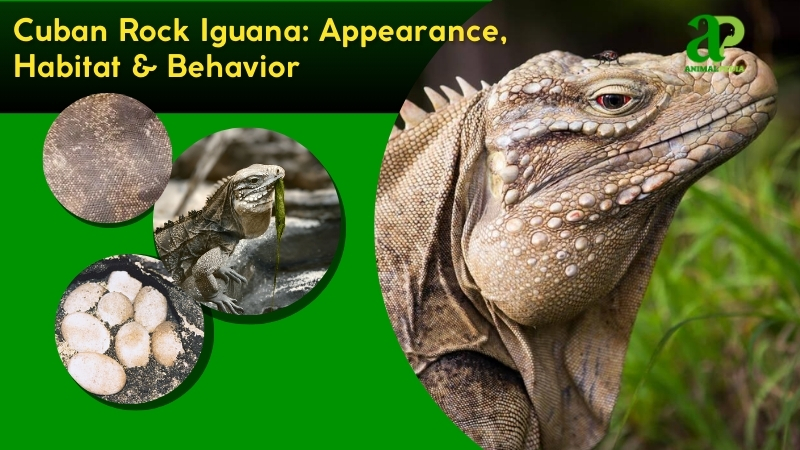
What do the Cuban Rock Iguanas look like?
The Cuban Rock Iguana (Cyclura nubila) has a robust, stocky body, averaging 40 cm (16 in) snout-to-vent length, with a tail doubling its total length to about 1.5 m (5 ft). Its coloration varies by sex: males display dark gray to reddish hues, while females are olive-green with dark bands, blending reinto Cuba’s rocky coastlines. The skin is coarse, covered in thick, keeled (ridged) scales, giving a rough texture, especially along the dorsal (back) surface, where scales are tightly packed and tuberculate (bumpy).
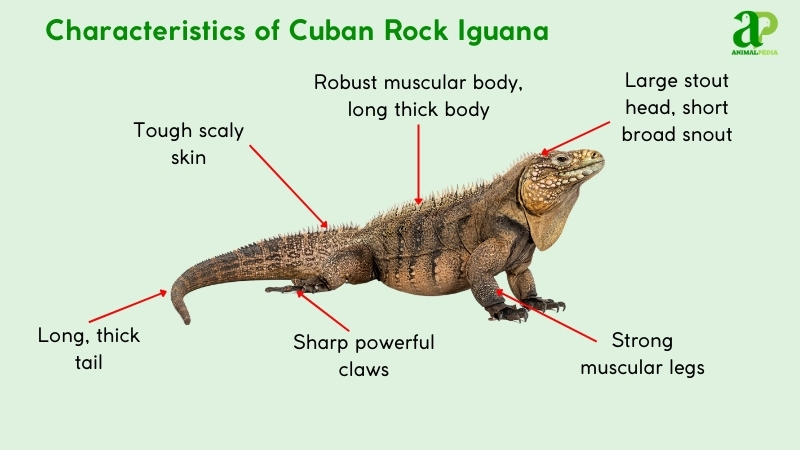
Starting with the head, it’s broad, with unique scalation patterns that act as a “fingerprint.” The eyes feature striking crimson sclera and golden irises, aiding UV detection. The tongue is thick and forked, used for chemoreception (scent detection). The neck bears a prominent dewlap (skin flap) with spiny edges, followed by a muscular body with a row of dorsal spines. Limbs are short and powerful, ending in sharp, curved claws for climbing. The tail, thick and ringed, is a defensive whip.
Compared to the Grand Cayman Blue Iguana (C. lewisi), the Cuban species lacks the vibrant blue hue and has a stockier build. Unlike the green iguana (Iguana iguana), it’s terrestrial rather than arboreal, with duller colors and tougher scales suited to rocky habitats (Shaney et al., 2020).
Explore more: Squamata – Species Guide, Life Cycles and Adaptations
How big do Cuban Rock Iguanas get?
The Cuban Rock Iguana (Cyclura nubila) has an average snout-to-vent length of 16 in (40 cm) and weighs about 15 lbs (7 kg). Adult males typically reach 5 ft (1.5 m) snout-to-tail, while females are slightly smaller. The longest and heaviest recorded specimen measured 5.2 ft (1.6 m) and weighed over 20 lbs (9 kg), documented at Guantanamo Bay Naval Base, Cuba, in a 2020 study (Shaney et al., 2020).
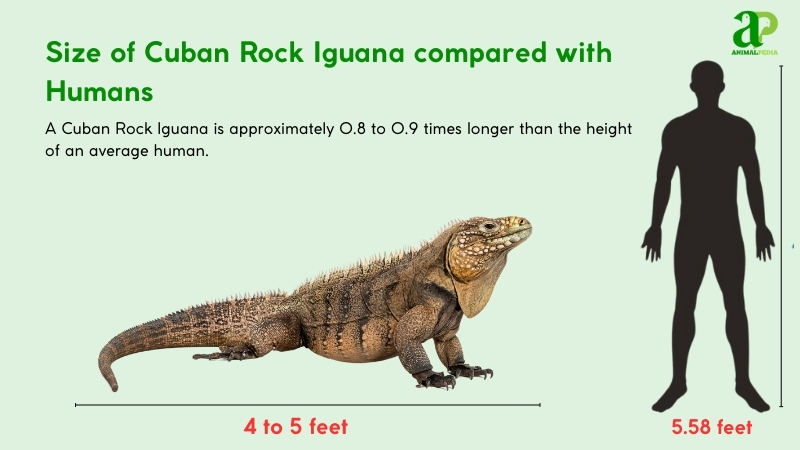
Males are significantly larger and heavier than females, with males averaging 5 ft (1.5 m) and 7-9 kg (15-20 lbs), while females reach about 4 ft (1.2 m) and 9-13 lbs (4-6 kg). This sexual dimorphism is evident in body mass and length. Below is a table of differences:
| Feature | Male | Female |
| Length (ft/m) | 5 ft (1.5 m) | 4 ft (1.2 m) |
| Weight (lbs/kg) | 15-20lbs (7-9 kg) | 9-13lbs (4-6 kg) |
What are the unique physical characteristics of the Cuban Rock Iguana?
The Cuban Rock Iguana boasts a unique physical trait: its intricate dorsal scalation pattern, which acts as an individual “fingerprint.” Unlike other iguana species, such as the green iguana (Iguana iguana) or the Grand Cayman Blue Iguana (C. lewisi), this pattern features tightly packed, keeled (ridged) scales with tuberculate (bumpy) protrusions along the back, which vary distinctly between individuals. This characteristic is not only visually striking but also serves as a key identifier in wild populations, setting it apart from its relatives.
Recent studies reveal that this scalation is linked to genetic diversity and environmental adaptation. Research from 2020 shows that the dorsal scales’ arrangement results from localized evolutionary pressures in Cuba’s rocky karst landscapes, enhancing camouflage and thermoregulation. The scales’ unique microstructure, observed via scanning electron microscopy, shows a higher density of keratinized tubercles than in other Cyclura species, which aids abrasion resistance (Shaney et al., 2020). This adaptation underscores the iguana’s resilience in its harsh, predator-scarce habitat.
The Cuban Rock Iguana’s dorsal “fingerprint” of ridged, tuberculate scales boosts camouflage, heat balance, and abrasion resistance in karst terrain. For a horned, heavier comparison, see Rhinoceros Iguana characteristic.
How do Cuban Rock Iguanas adapt with their unique features?
The Cuban Rock Iguana’s unique dorsal scalation aids survival by providing camouflage against Cuba’s rocky terrain, reducing predation risk. These keeled, tuberculate scales enhance thermoregulation, allowing the iguana to bask efficiently on sunlit rocks while resisting abrasion from sharp surfaces (Shaney et al., 2020).
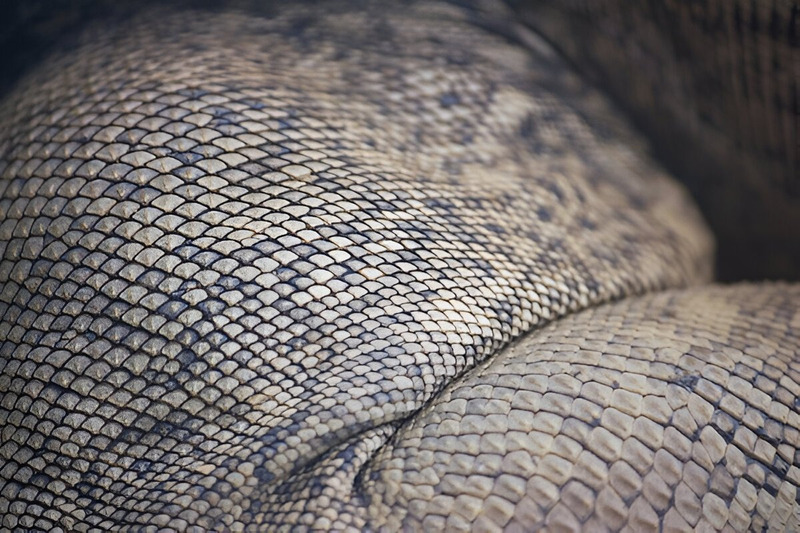
This trait is supported by sharp senses. Its crimson sclera eyes detect UV light, improving predator detection. A forked tongue with chemoreceptors senses chemical cues, locating food in sparse habitats. Acute hearing from the tympanic membranes alerts it to threats, enhancing vigilance. Robust olfactory glands in the nasal cavity track scents, aiding navigation in rocky landscapes. Together, these senses optimize adaptation to its rugged environment.
Anatomy
The Cuban Rock Iguana (Cyclura nubila), a hardy terrestrial reptile native to Cuba’s rocky coastlines, has specialized physiological systems tailored to its rugged environment:
- Respiratory System: Features efficient lungs with air entering via the nostrils, passing through the trachea to the alveoli, oxygenating blood for basking and foraging, and sustaining its dark gray to reddish hues.
- Circulatory System: Has a three-chambered heart (two atria, one ventricle) with partial septation, typical of iguanids, supplying oxygen to muscles for climbing and supporting its stocky frame.
- Digestive System: Includes a capacious stomach and long intestines for breaking down tough vegetation such as fruits and leaves, with strong jaws that grind fibrous material.
- Excretory System: Paired kidneys excrete uric acid via the cloaca, conserving water in arid habitats, relying on sparse dew and plant moisture.
- Nervous System: Comprises a developed brain and spinal cord, with sharp crimson-sclera eyes spotting threats 5–10 meters (16–33 feet) away and a forked tongue detecting chemical cues, aiding survival.
Ultimately, the anatomy of the Cuban Rock Iguana is finely tuned for a life of freedom and survival in the wild.
Where do Cuban Rock Iguanas live?
The Cuban Rock Iguana is distributed across mainland Cuba and over 4,000 surrounding islets, with notable concentrations in Guanahacabibes Biosphere Reserve (west), Isla de la Juventud (south), and Desembarco del Granma National Park (east). A feral population thrives on Isla Magueyes, Puerto Rico, and a subspecies (C. n. caymanensis) inhabits Little Cayman and Cayman Brac.
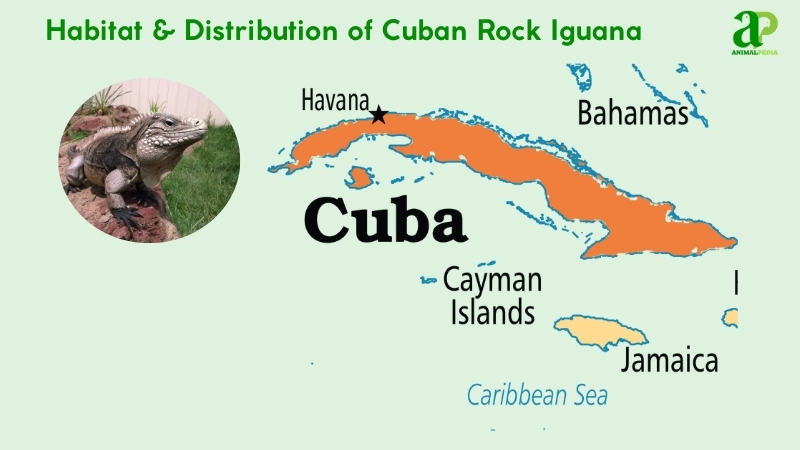
These areas feature rocky coastal habitats with limestone formations, sandy beaches, and dry tropical forests—ideal for the iguana’s terrestrial lifestyle. The rough terrain offers camouflage through its unique dorsal scales, while sparse vegetation, such as cacti, provides food and shelter, supporting its herbivorous diet and basking needs. Research (Shaney et al., 2020) suggests they’ve inhabited Cuba since the Pliocene (2-3 million years ago), with no significant migration, evolving in situ from ancestral populations as sea levels rose and fell.
How do seasonal changes affect their behavior?
The Cuban Rock Iguana adapts its behavior to Cuba’s wet season (May–October) and dry season (November–April), thriving in its rocky, coastal habitat. These adjustments enhance survival amid fluctuations in food and water availability in a tropical climate.
Males exhibit territorial behavior year-round, peaking in the wet season with head-bobbing and dewlap displays to attract mates. In the wet season, they forage 40–60 meters daily for fruits and leaves, dropping to 20–40 meters in the dry season. Breeding surges in the wet season, with females laying eggs in sandy burrows that hatch by late wet or early dry months.
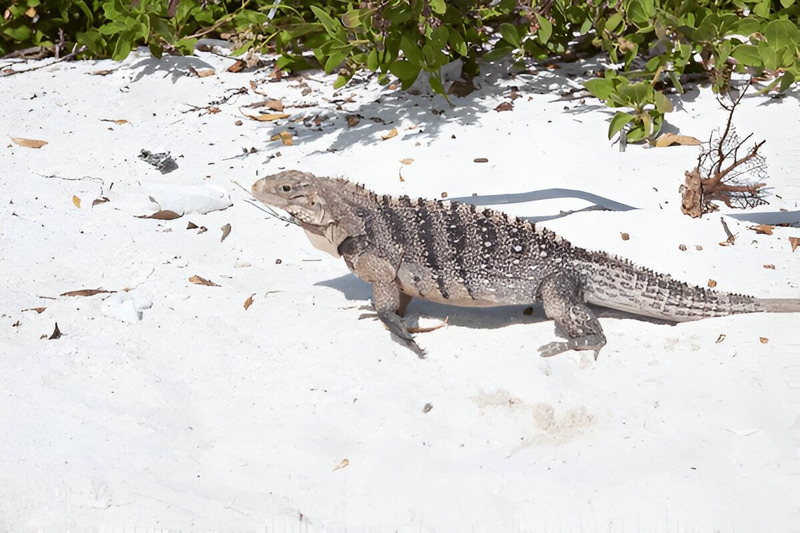
- Wet Season (May–October)
Activity increases, covering 25–35 m2 as vegetation thrives in 80–90% humidity and 28–32°C (82–90°F). Basking lasts 1–2 hours, supported by frequent rain.
- Dry Season (November–April)
Movement decreases 30–40%, conserving energy as food dwindles. Basking extends to 3–5 hours in 25–29°C (77–84°F), optimizing heat in drier 60–70% humidity
What is the behavior of the Cuban Rock Iguana?
The Cuban Rock Iguana has distinct traits and behaviors as follows:
- Diet: Strictly herbivorous, mainly feeding on fruits, leaves, and flowers, with seasonal and age-related variations.
- Hunting Mechanisms: Primarily forages for plants, using strong jaws and flat teeth to grind tough plant material.
- Daily Activity Patterns: Diurnal, most active in the early morning and late afternoon, basking and foraging.
- Locomotion Capabilities: Moves with a deliberate stride on land; skilled swimmer using its tail in water.
- Social Structure: Prefers living in small groups or colonies, which provide safety and promote social bonds.
- Communication: Uses body language like head-bobbing, throat puffing, and color changes to assert dominance or signal emotions.
To learn more about their foraging habits, movement patterns, and social dynamics, keep reading!
What do Cuban Rock Iguanas eat?
The Cuban Rock Iguana is strictly herbivorous, feeding mainly on fruits, leaves, and flowers in Cuba’s rocky coastal habitats. Unlike carnivorous iguanids, it uses robust jaws and flat teeth to grind tough plant material, foraging terrestrially across limestone terrain, an adaptation to its sparse, dry environment.
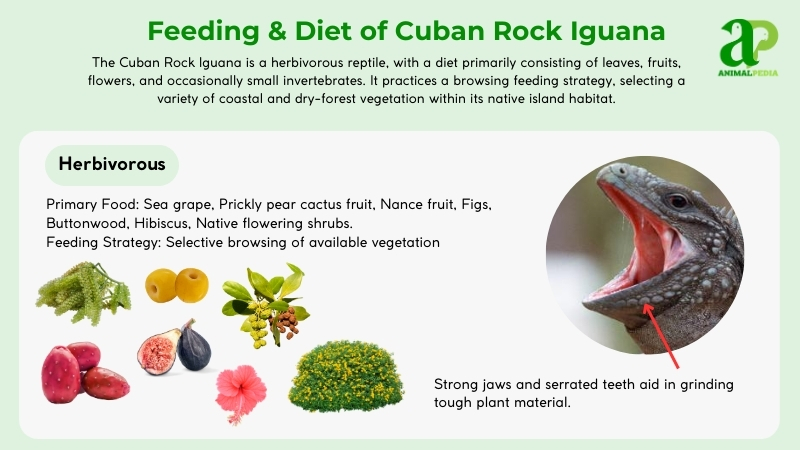
Diet by Age
Diet shifts with age, reflecting growth and energy demands.
- Hatchlings (0–1 Year): Consume soft leaves and rare insects, supporting early growth near burrows.
- Juveniles (1–3 Years): Eat tougher leaves and fruits, foraging up to 20–40 meters daily to build strength.
- Subadults (3–8 Years): Focus on denser vegetation and expand range to build mass.
- Adults (8+ Years): Prefer fruits and thick leaves; males defend prime feeding areas.
Diet by Gender
Males and females share diets and bite and grind food without chewing adaptations.
Diet by Seasons
As opportunistic herbivores, they adjust their feeding patterns seasonally. In the wet season (May–October), they target abundant fruits; in the dry season (November–April), they rely on leaves, coping with scarcity
How do Cuban Rock Iguanas hunt their prey?
Cuban Rock Iguanas are skilled hunters, utilizing their sharp claws and agile bodies to capture prey efficiently. These predators rely on their excellent eyesight and quick reflexes to catch insects, small reptiles, and bird eggs. With a blend of stealth and patience, they wait for the right moment to strike, often ambushing unsuspecting prey with precision.
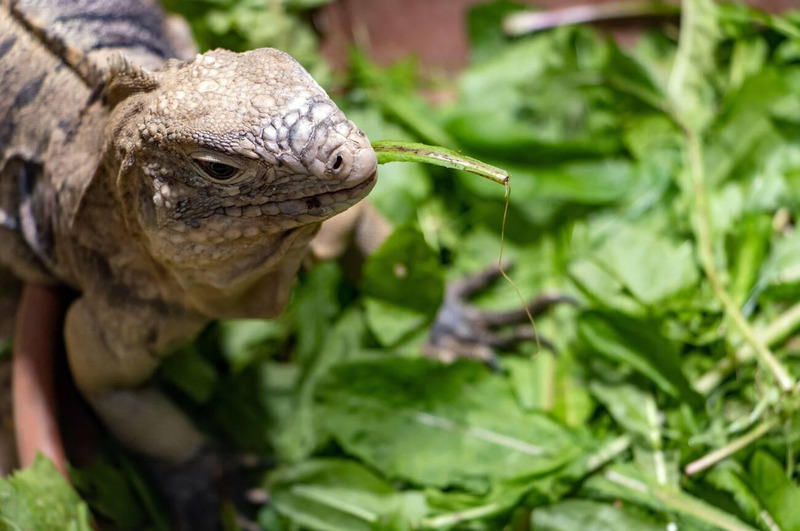
Their ability to climb trees and navigate rocky terrain effortlessly gives them an advantage in capturing food. Cuban Rock Iguanas showcase their adaptability and intelligence through these hunting behaviors, which are crucial for their survival in their natural habitat. Witnessing these majestic creatures in action offers a glimpse into the beauty and diversity of the animal kingdom, highlighting the fascinating ways in which they secure their meals in the wild.
Are Cuban Rock Iguanas venomous?
Cuban Rock Iguanas don’t use venom as a predatory tool. Instead, they rely on their territorial nature to defend themselves. These iguanas are known for fiercely defending their territory when threatened, using their powerful jaws and sharp teeth as a last resort.
However, their primary defense mechanism is their impressive size and agility, which allow them to escape danger by swiftly climbing trees or rocky outcrops.
While they aren’t venomous, Cuban Rock Iguanas showcase intriguing behaviors in their natural habitat. They communicate through body language and color changes, enabling interactions with other iguanas and expressing emotions.
Observing these captivating creatures basking in the sun or gracefully maneuvering through their environment is a true delight for wildlife enthusiasts. Despite their lack of venom, the behaviors of Cuban Rock Iguanas are full of wonder and fascination.
When are Cuban Rock Iguanas most active during the day?
Cuban Rock Iguanas tend to be most active in the early morning and late afternoon. They enjoy soaking up the morning sun’s warmth to kickstart their day energetically. Throughout the day, they explore their surroundings, forage for food, and bask in the sunlight.
In the late afternoon, they can be spotted moving around as they make the most of the dwindling daylight.

During their active periods, Cuban Rock Iguanas exhibit lively behaviors that showcase their unique personalities. You may observe them climbing rocks or trees, stretching their impressive bodies, or engaging in playful interactions with fellow iguanas. Watching them during these times offers a delightful experience, highlighting their agility and graceful movements.
How do Cuban Rock Iguanas move on land and water?
When Cuban Rock Iguanas move on land, they display a distinct and deliberate stride, using their strong limbs to propel themselves forward. These fascinating creatures travel with a sense of freedom and determination, their sleek bodies smoothly gliding across the terrain. Their movements are graceful yet purposeful, showcasing their agility and strength.
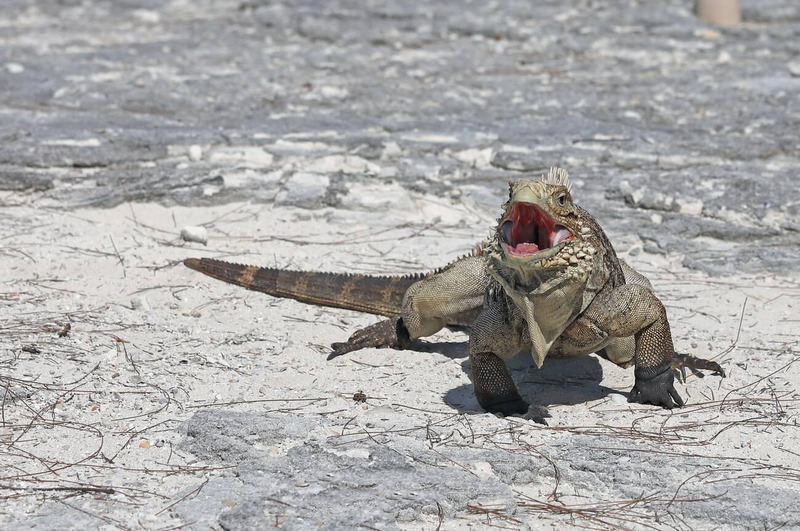
In the water, Cuban Rock Iguanas are surprisingly skilled swimmers, utilizing their tails to navigate through the depths with speed and agility. They demonstrate their versatility by moving effortlessly between different environments.
Whether on land or in water, Cuban Rock Iguanas exhibit confidence and adaptability in their motions, seamlessly adjusting to their surroundings.
Watching these creatures in action is truly captivating as they effortlessly transition between land and water. Cuban Rock Iguanas epitomize freedom and resilience, displaying adaptability and elegance in every movement they make.
Do Cuban Rock Iguanas live alone or in groups?
Cuban Rock Iguanas are social creatures that prefer living in small groups called colonies. These iguanas enjoy the company of their fellow reptiles, often seen sunbathing or foraging for food together. Group living offers them safety in numbers, as they can watch out for predators and alert each other to potential dangers. Within these colonies, communication through gestures and displays strengthens their bonds
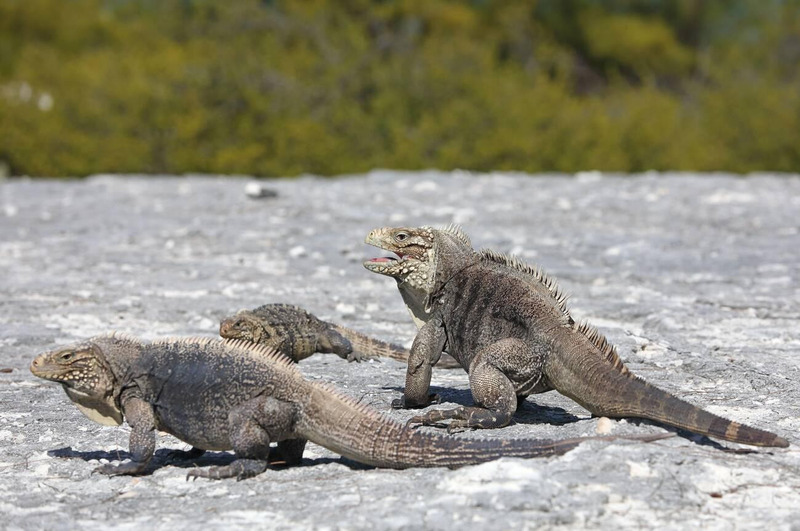
Living in groups enables Cuban Rock Iguanas to share resources and navigate their rocky habitats more effectively. Hierarchical structures may be observed, with dominant members leading and others following suit. Group living enhances their chances of survival in their environment.
In the wild, Cuban Rock Iguanas form colonies to support one another, creating a cooperative, interactive social structure that benefits their overall well-being and survival. The dynamics within these groups showcase the fascinating behaviors and relationships of these unique reptiles.
How do Cuban Rock Iguanas communicate with each other?
Cuban Rock Iguanas communicate with one another through a variety of behavioral signals and cues. These fascinating creatures use head movements, body postures, and color changes to convey their intentions and emotions to fellow iguanas.
For instance, when a male Cuban Rock Iguana wants to assert dominance, he may raise his head and puff out his throat to appear larger and more intimidating. This display helps establish his position within the group and deters potential threats.
On the other hand, if a Cuban Rock Iguana feels threatened, it may flatten its body against the ground to appear smaller and less noticeable to predators. This defensive posture helps blend into the surroundings and avoid detection.
Additionally, these iguanas may engage in push-up displays to communicate submission or readiness for mating rituals. These forms of communication are vital for their survival and social interactions in the wild.
How do Cuban Rock Iguanas reproduce?
The Cuban Rock Iguana (Cyclura nubila) reproduces sexually via oviparity (egg-laying). Breeding begins in May, during the wet season. Males intensify territorial displays—head-bobbing and dewlap extensions—to attract females, while females signal receptivity by approaching. Courtship involves males nudging females, followed by brief copulation.
Post-mating, females lay 3–30 eggs (average 15) in June–July, each weighing about 70–100 grams (2.5–3.5 oz). Eggs are buried in sandy nests, often under rocks, with females guarding briefly before leaving. Males resume territorial patrols. Egg-laying can be disrupted by habitat disturbance, as noted in studies from Guantanamo Bay in 2018 (Shaney et al., 2020).
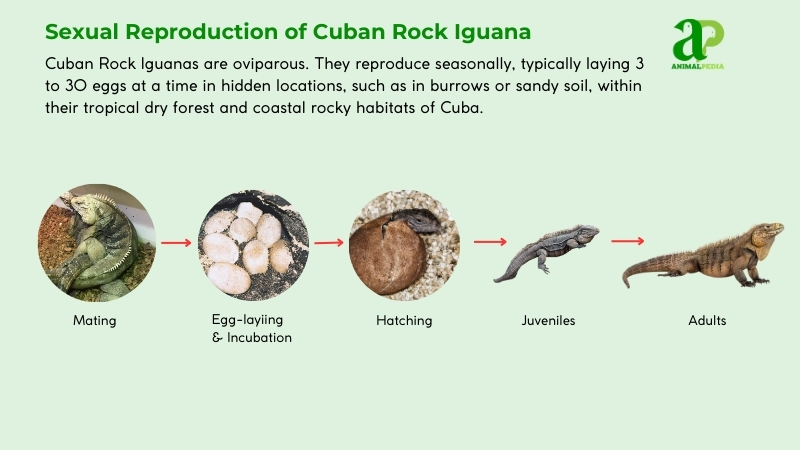
Incubation lasts 70–100 days, with hatchlings emerging in September–October, measuring 25–30 cm (10–12 in). Juveniles grow rapidly, reaching maturity at 8–9 years, feeding on soft vegetation. Predation and habitat loss threaten early survival.
The life cycle spans 20–30 years in the wild, longer in captivity (up to 40 years). Sexual dimorphism influences reproductive success, with larger males dominating breeding. Conservation efforts highlight population declines driven by human impacts.
How long do Cuban Rock Iguanas live?
The Cuban Rock Iguana has a life cycle of 20–30 years in the wild, extending to 40 years in captivity. It reaches maturity at 8–9 years, with reproduction peaking in the wet season. Notes include vulnerability to habitat loss and to predation, which affect juvenile survival.
The average lifespan in the wild is approximately 25 years, with no significant difference between males and females. In captivity, both sexes can live to 35 years or more under optimal conditions, though males may experience greater stress from territorial disputes.
What are the threats or predators that Cuban Rock Iguanas face today?
The Cuban Rock Iguana (Cyclura nubila) faces multiple threats: habitat loss, predation by invasive species, human disturbance, and climate change. These jeopardize its survival across Cuba and the surrounding islets.
- Habitat Loss: Agricultural expansion and urban development destroy rocky coastal habitats, reducing nesting and foraging sites by 20–30% in some areas, severely limiting population growth.
- Predation by Invasive Species: Feral cats, dogs, and pigs prey on hatchlings and juveniles, with cats alone causing up to 90% mortality in some populations, drastically skewing age demographics.
- Human Disturbance: Tourism and infrastructure disrupt breeding and basking, increasing stress and reducing reproductive success by 10–15% in affected zones.
- Climate Change: Rising temperatures and sea levels alter habitats and food availability, potentially shrinking viable territory by 15–25% over decades, challenging thermoregulation.
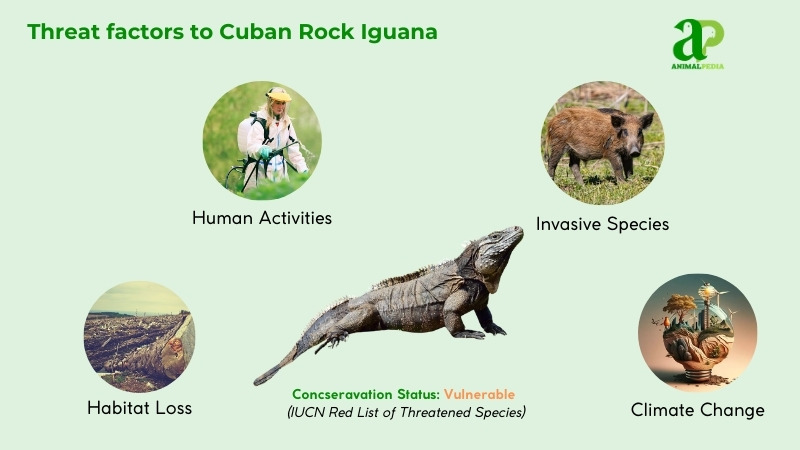
Predators include feral cats, dogs, pigs, and native hawks (Buteo spp.). Cats are the most impactful, targeting vulnerable young, while hawks occasionally take juveniles.
Human impact is profound, with habitat destruction from agriculture and tourism reducing populations by an estimated 40,000–60,000 individuals in Cuba. Feral animal introductions exacerbate predation, and coastal development at sites like Guantanamo Bay Naval Base fragments habitats. Research by Shaney et al. (2020) documents these effects, noting declines in genetic diversity and recruitment due to human activities, and urges conservation action.
Are Cuban Rock Iguanas endangered?
The Cuban Rock Iguana (Cyclura nubila) is endangered. It is currently listed as Vulnerable (VU) on the IUCN Red List. The Vulnerable status indicates a high risk of extinction in the wild if threats persist, though it’s less severe than the Endangered or Critically Endangered categories.
Population estimates suggest 40,000–60,000 individuals remain in Cuba, primarily across the mainland and its 4,000+ islets, with a feral population of over 1,000 on Isla Magueyes, Puerto Rico. The Little Cayman population is about 1,500, while Cayman Brac has fewer than 50.
These figures come from Shaney et al. (2020), which highlights declining numbers and low effective population sizes in many areas due to habitat loss and predation. The study emphasizes genetic differentiation and the need for updated assessments, as some populations face higher risks than the overall Vulnerable label suggests.
What conservation efforts are underway?
Conservation efforts for the Cuban Rock Iguana focus on habitat protection and population recovery, primarily led by the International Iguana Foundation (IIF) and San Diego Zoo Wildlife Alliance. Since the 1990s, the IIF has targeted habitat restoration and invasive species control across Cuba’s coastal regions, with intensified efforts from 2016 onward to bolster populations. The San Diego Zoo initiated a headstarting program in 1993, protecting hatchlings until they’re resilient, and it continues into the 2020s.
Legal protections include Cuba’s 1999 designation of key habitats, such as the Guanahacabibes Biosphere Reserve, as protected areas, prohibiting development and hunting. The U.S. Endangered Species Act (ESA) lists the species as Vulnerable, and since 1973 has banned trade and the capture of wild specimens. The introduction of invasive species, such as cats and pigs, is also restricted to curb predation.
Breeding programs have excelled, with the San Diego Zoo’s efforts yielding over 1,000 hatchlings released into Cuba and Puerto Rico since 2002. The IIF’s headstart in Cuba has increased survival rates by 50%, releasing hundreds annually. A success story is the Isla Magueyes population, which grew from a few dozen in the 1960s to over 1,000 by 2020 through controlled breeding and releases.
Research by Shaney et al. (2020) confirms these efforts stabilize genetic diversity, with the Little Cayman population rising from 50 to 1,500 since 2010. Key organizations, including the IUCN Iguana Specialist Group, drive these victories, showcasing effective conservation.
Frequently Asked Questions
Are Cuban Rock Iguanas Endangered?
Yes, Cuban rock iguanas are endangered due to habitat loss and poaching. Conservation efforts, including captive-breeding programs, have been successful in increasing their numbers. Your awareness and support can help protect these magnificent creatures.
Do Cuban Rock Iguanas Interact With Humans?
You, as a nature lover, might wonder if Cuban rock iguanas interact with humans. They generally avoid human contact but might approach for food. Respect their space so they can enjoy observing these fascinating creatures.
How Long Can Cuban Rock Iguanas Live?
You can expect Cuban rock iguanas to live up to 20 years in the wild, but in captivity, they may thrive up to 40 years. Providing proper care and an appropriate environment is vital to their longevity.
Do Cuban Rock Iguanas Have Any Unique Adaptations?
Cuban rock iguanas boast unique adaptations, such as tough, spiky skin that provides camouflage against predators and protection from the heat. Their burrowing skills and ability to store fat help them survive in harsh environments.
What Conservation Efforts Are in Place for Cuban Rock Iguanas?
To protect Cuban rock iguanas, conservation programs are in place, including captive breeding, which is helping boost their numbers. These efforts aim to save this endangered species and ensure its survival in the wild for future generations to enjoy.
Conclusion
The Cuban Rock Iguana is an impressive reptile with unique physical features, adaptive habitats, and fascinating social behavior. From their sturdy bodies to their cooperative interactions in small colonies, these iguanas are truly a marvel of nature. As they face threats from predators and habitat loss, it’s important to appreciate and protect these incredible creatures for future generations to enjoy. The Cuban Rock Iguana is a species worth learning about and preserving for the future!





